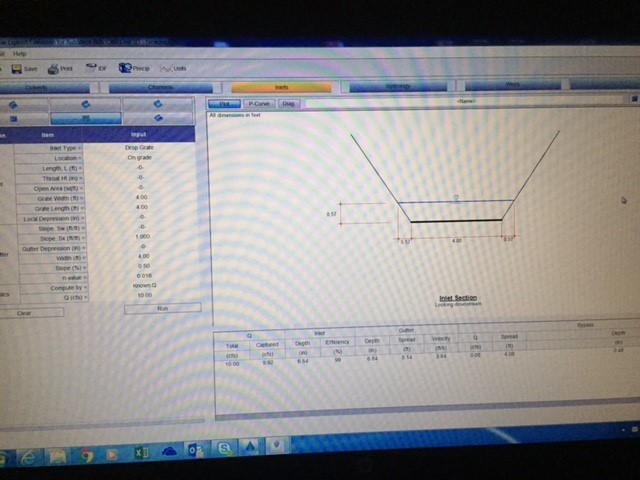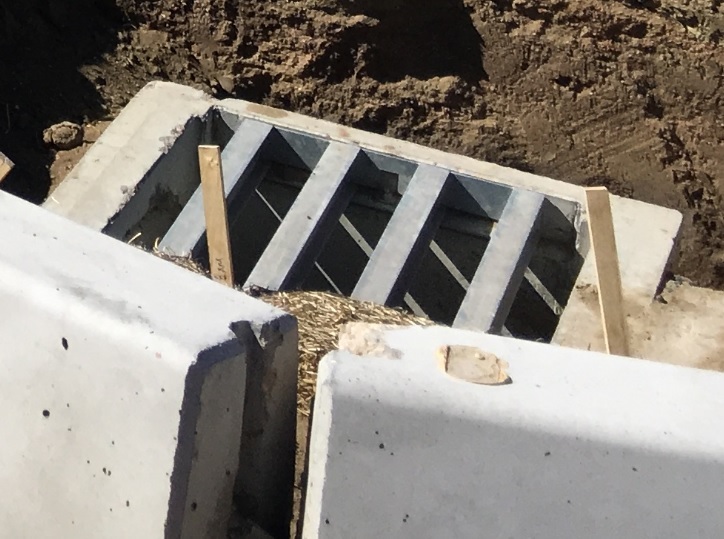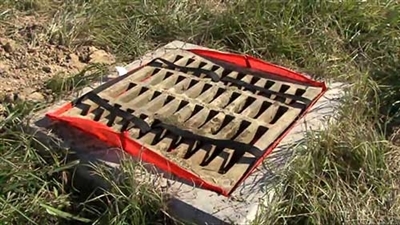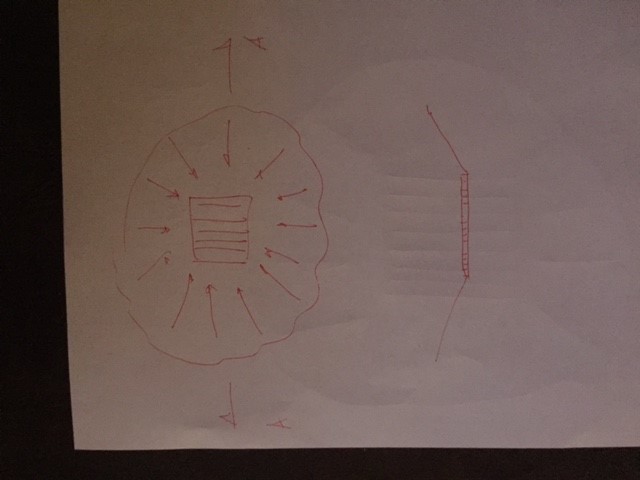Navigation
Install the app
How to install the app on iOS
Follow along with the video below to see how to install our site as a web app on your home screen.
Note: This feature may not be available in some browsers.
More options
Style variation
-
Congratulations cowski on being selected by the Eng-Tips community for having the most helpful posts in the forums last week. Way to Go!
You are using an out of date browser. It may not display this or other websites correctly.
You should upgrade or use an alternative browser.
You should upgrade or use an alternative browser.
does storm inlet have Q discharge capacity? 2
- Thread starter delagina
- Start date
- Status
- Not open for further replies.
- Thread starter
- #2
I thinks this was the inlet that was used. This doesn't show any Q capacity though.
The "capacity" will depend on how the grate is installed, and how much head is allowed, so there is no single value. A grate in a sump situation can typically handle more then a flush grate. From your picture, the grate actually seems to be raised above the surrounding ground, which could cause much of the flow to bypass the grate.
I'm guessing that you have an issue with the adequacy of this inlet? If so, more information is needed in order to provide meaningful feedback.
Peter Smart
HydroCAD Software
I'm guessing that you have an issue with the adequacy of this inlet? If so, more information is needed in order to provide meaningful feedback.
Peter Smart
HydroCAD Software
-
1
- #4
suggest calculating the capacity using the following reference and since this inlet is covered with some sort of filter, the capacity will be greatly reduced. suggest also using a generous clogging factor
msquared48
Structural
In years past I saw a graph of the inlet capacity for a standard Type 1 CB grate. I don't think it was in the APWA manual though...
Mike McCann, PE, SE (WA)
Mike McCann, PE, SE (WA)
- Thread starter
- #6
- Thread starter
- #7
I have hydraflow inlet calculation software.
The inputs are very simple and basic. I just put the width and length of grate and my Q.
But I'm not understanding the output.
If you will look at the output picture, there is water above the grate inlet.
Why would there be water above grate inlet if the inlet was designed for Q?
attached are input and output pic from hydraflow


The inputs are very simple and basic. I just put the width and length of grate and my Q.
But I'm not understanding the output.
If you will look at the output picture, there is water above the grate inlet.
Why would there be water above grate inlet if the inlet was designed for Q?
attached are input and output pic from hydraflow


-
1
- #8
The inlet capacity will be a function of the depth of water "standing" above the inlet. Once the inlet is submerged the orifice equation is used to calculate the capacity based on the open area of the grate (less any assumptions for blockage). You can create a table of depth versus flow and then determine is the peak Q from the drainage area can be passed by the inlet at an acceptable ponded depth.
- Thread starter
- #10
- Thread starter
- #11
also attached is the actual grate inlet but I cant find on DOT drawing the "open area" of the grate inlet.


If you've got 100 feet of head over that inlet, the capacity will be pretty large.
Hydrology, Drainage Analysis, Flood Studies, and Complex Stormwater Litigation for Atlanta and the South East -
Hydrology, Drainage Analysis, Flood Studies, and Complex Stormwater Litigation for Atlanta and the South East -
- Thread starter
- #14
It's honestly pretty dangerous and somewhat frustrating to watch untrained people try to muddle their way through site hydraulics by trusting in computer software that they don't understand the inputs and outputs on. You're begging to get sued over a design failure with this whole chain of questioning.
Read CVG's link to HEC-22. It's comprehensive, and will explain to you step by step what the software is doing. The Hydraflow overlay in Civil-3D basically just automates that PDF.
Hydrology, Drainage Analysis, Flood Studies, and Complex Stormwater Litigation for Atlanta and the South East -
Read CVG's link to HEC-22. It's comprehensive, and will explain to you step by step what the software is doing. The Hydraflow overlay in Civil-3D basically just automates that PDF.
Hydrology, Drainage Analysis, Flood Studies, and Complex Stormwater Litigation for Atlanta and the South East -
- Thread starter
- #16
I'm not designing anything just verifying the county inlet is good. I can take your for word for it (some of posters said don't worry about it) that it's good or I can at least try to check it. I'm not checking a complicated drainage here, just one pipe culvert with an inlet in the middle.
- Thread starter
- #17
Don't worry nothing dangerous here at all. The worst that can happen is the "standing" water above the inlet is actually a few inches above or even below. The site is also not in the flood zone. As I said, county installed/designed this inlet. Just checking how much "standing" water above the inlet.
JedClampett
Structural
We had the Neenah engineer give a lunch and learn a few weeks ago. I'm not a hydraulic guy, but I remember him saying that they don't publish numbers for grates, just for curb inlets. I was lunching more than learning then, so I don't remember why, but it made sense. My impression was that they have the data, but it wasn't that important for this type of orientation. I bet if you call Neenah, they could help you out.
darthsoilsguy2
Geotechnical
you can fiddle around with the link below... i've never used it before but it seems reasonable... i've always had so many grates to handle low spots or cut down on overland flows, that i've ever been concerned with localized concentration of flows exceeding the grate capacity. of course the temp witch hat in the photo changes everything, but i assume you are modeling operational flows....
- Status
- Not open for further replies.
Similar threads
- Question
- Replies
- 1
- Views
- 2K
- Question
- Replies
- 2
- Views
- 798
- Locked
- Question
- Replies
- 3
- Views
- 767
- Locked
- Question
- Replies
- 19
- Views
- 1K
- Locked
- Question
- Replies
- 2
- Views
- 421



